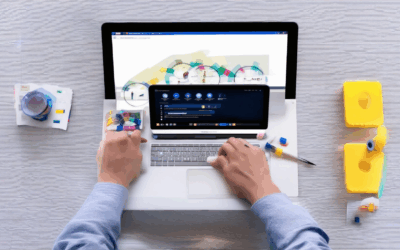In the fast-paced digital world we live in, modern web design has become more than just a trend—it’s a necessity. As technology continues to evolve, so do the expectations of users, demanding sleek, functional, and visually appealing online experiences. Whether you’re building a new website or optimizing an existing one, understanding modern web design principles is crucial for creating a site that not only stands out but also resonates with your audience. This guide delves into the key aspects of modern web design, exploring what sets it apart, the best resources for finding inspiration, and actionable tips for implementing these designs yourself. From mastering the latest trends to discovering top sources for creative ideas, this comprehensive exploration will equip you with everything you need to stay ahead in the game of web design.

Defining Modern Web Design
Modern web design encompasses a combination of cutting-edge principles and practices that aim to create visually appealing, user-friendly, and functional websites. Here are the key elements that define contemporary web design:
- User-Centric Experience: Modern web design prioritizes user experience (UX), focusing on how users interact with and perceive the website. It emphasizes intuitive navigation, seamless functionality, and visually pleasing interfaces.
- Responsive Design: The ability of a website to adapt to various screen sizes and devices is crucial. Responsive design ensures that the site looks great on desktops, tablets, and mobile phones alike.
- Flat Design: Characterized by minimal depth, flat design uses simple colors, typography, and shapes to create a clean and focused aesthetic. It is widely popular due to its versatility and modern appeal.
- Web Standards Compliance: Adherence to W3C standards ensures cross-browser compatibility and future-proofing. Modern designers also focus on accessibility, making sure their sites are usable by everyone, including individuals with disabilities.
- Performance Optimization: Speed is king in web design. Techniques like image optimization, CSS frameworks, and code minimization are employed to ensure fast load times and smooth interactions.
- Browser Compatibility: Modern web design requires testing across multiple browsers (Chrome, Firefox, Safari, etc.) to ensure consistent rendering and functionality.
- Content Delivery Networks (CDNs): CDNs are used to deliver static assets faster by serving them from geographically distributed servers, reducing load times and improving overall performance.
- Search Engine Optimization (SEO): Integrated into modern web design, SEO techniques ensure high visibility in search engine results, driving organic traffic and boosting online presence.
- Progressive Web Apps (PWAs): Combining the best of web and app experiences, PWAs offer fast loading times, offline functionality, and the ability to install apps on devices, enhancing user engagement.
- HTML5 and CSS3: These updates to web standards enable richer, more interactive designs, facilitating complex layouts and animations without relying on external plugins.
- JavaScript Frameworks: Popular frameworks like React, Angular, and Vue.js enable developers to build dynamic and interactive web applications with ease, enhancing user engagement and functionality.
- UI Kits and Design Systems: These resources provide consistent design elements, simplifying the creation of uniform and maintainable interfaces across different pages.
- Micro-Interactions: Small animations and feedback mechanisms enhance user interaction, making the experience more engaging and intuitive.
- Security Measures: Protecting user data is paramount. Modern web design incorporates HTTPS encryption, secure data handling, and regular security audits to safeguard information.
By combining these elements, modern web design creates immersive and effective digital experiences that cater to both form and function, setting new standards for user satisfaction and success.
What are the best sources for modern web design inspiration?
Discover the top platforms and tools that inspire modern web design:
1. Design Inspiration Platforms
- Dribbble – A premier destination for web and graphic design inspiration, showcasing cutting-edge work from global designers.
- Behance – Part of the Adobe family, this platform hosts an extensive collection of web and app designs.
- Smashing Magazine – Known for its high-quality articles and design showcases, Smashing Magazine covers the latest trends and techniques.
- Design Milk – Features a variety of design categories, including web design, typography, and branding.
2. Design Communities and Forums
- Webflow Community – Engaging community of designers and developers sharing ideas and projects.
- CSS Working Group (CSSWG) – While technical, this group discusses web design standards and practices.
- Stack Overflow – A treasure trove of web design questions, solutions, and learning opportunities.
3. Video Content and Tutorials
- YouTube Channels – Channels like Adobe Creative Cloud and UI Breakfast offer valuable video content.
- Vimeo – Features a selection of high-quality web design videos and case studies.
4. Design Trends and Resources
- Minimalist and Flat Design – Continuing to influence modern web design with clean layouts and simple aesthetics.
- Retro and Vintage Styles – Reviving classic design elements for a nostalgic touch.
- Micro-interactions – Enhancing user experience with subtle animations and feedback.
- 3D Elements – Integrating 3D effects using technologies like WebGL and Three.js.
- Accessibility-Driven Design – Prioritizing inclusivity and usability in modern web design.
5. Notable Designers and Studios
- Interaction Design Foundation – Featuring interviews and works from leading designers.
- Figma and Sketch – Popular design tools with active communities and resources.
- AIGA – The American Institute of Graphic Arts provides design-related events and educational materials.
These sources provide a wealth of inspiration and resources for web designers seeking to stay ahead in the field. Explore these platforms to discover the latest trends and techniques in modern web design.

Creating a Modern-Looking Website Design
To craft a modern website design, focus on combining clean aesthetics, functionality, and user-centric experiences. Here’s a structured approach:
- 1. Responsive Layout Design
- Use CSS Grid and Flexbox for adaptable layouts that work across devices.
- Test designs on various screen sizes using tools like BrowserStack.
- 2. Modern Color Palette
- Choose a cohesive color scheme aligned with your brand, using tools like color wheels for harmony.
- Opt for vibrant accents against neutral tones to enhance visual appeal.
- 3. Clean Typography
- Select sans-serif fonts like Helvetica or Roboto for readability and modernity.
- Maintain consistency in font styles and sizes across the site.
- 4. Strategic Whitespace
- Use ample white space to reduce clutter and enhance readability.
- Ensure uniform spacing throughout the design for a polished look.
- 5. Subtle Animations
- Integrate smooth transitions and hover effects without overwhelming users.
- Ensure animations do not hinder site performance.
- 6. Content Organization
- Present information using cards or modules for neat organization.
- Style these elements consistently for a cohesive design.
- 7. Image Optimization
- Use high-quality images optimized for fast loading times.
- Add descriptive alt texts for accessibility and SEO.
- 8. Responsive Navigation
- Implement a sticky header with a responsive menu.
- Plan menu items carefully, hiding some on mobile for better usability.
- 9. SEO and Accessibility
- Optimize meta tags and alt texts for improved visibility and accessibility.
- Ensure proper contrast ratios and readable fonts for all users.
- 10. Stay Updated
- Follow design trend blogs and join communities to stay informed.
- Experiment with new techniques and apply them to your site.

Key Characteristics of Modern Web Design
- Responsive Design: Modern web design prioritizes responsiveness, ensuring seamless functionality across various screen sizes and devices.
- CSS Frameworks: Utilization of frameworks like Bootstrap, Tailwind CSS, or Foundation simplifies the creation of consistent and efficient designs.
- Performance Optimization: Focus on reducing load times through techniques like lazy loading images, code minification, and optimizing asset delivery.
- Flat Design: Clean and minimalist interfaces dominate modern web design, avoiding clutter and focusing on simplicity.
- UI Consistency: Maintaining a uniform design language across platforms and devices ensures a cohesive user experience.
- Browser Compatibility: Ensuring cross-browser compatibility is critical to reach a broader audience and adhere to web standards.
- SEO Integration: Intrinsic SEO practices, such as meta tags, alt text, and structured data, are seamlessly integrated into design processes.
- Semantic HTML: The use of semantic HTML elements improves accessibility and SEO, ensuring content is easily understandable by search engines.
- Micro-interactions: Subtle animations and feedback mechanisms enhance user engagement and interaction.
- Accessibility: Designers now prioritize accessibility, ensuring websites are navigable and usable for people with disabilities.
- Custom Fonts and Typography: High-quality fonts and typography contribute significantly to the visual appeal and readability of a website.
- Progressive Enhancement: Building websites with a focus on functionality and content delivery, allowing for future enhancements without breaking existing designs.
The modern web design landscape emphasizes efficiency, usability, and innovation. By leveraging advanced tools and techniques, designers create visually appealing, functional, and future-ready websites that cater to diverse audiences and devices.
Explore our comprehensive web design services to discover how we can bring your digital vision to life.
Key Elements of Modern Web Design Inspiration
Modern web design inspiration is driven by several key elements that reflect current trends and innovations in the field. These elements not only define the aesthetic but also enhance user experience and functionality.
- Minimalist Layouts : Clean and uncluttered designs prioritize simplicity, focusing on negative space and essential elements to create a balanced look. Minimalist web designs often use monochromatic palettes with subtle accents to draw attention to key content.
- Bold Color Palettes : Vibrant and contrasting colors are frequently used to convey energy and emotion. Modern designers often combine unexpected color combinations, inspired by artistic movements and cultural trends, to create visually striking interfaces.
- Clean Typography : The emphasis on readable and visually appealing typefaces has led to the popularity of modern sans-serif fonts. Clean typography ensures content is easily digestible while maintaining a contemporary aesthetic.
- Responsive Design Principles : Flexibility and adaptability are crucial in web design. Modern designs utilize responsive layouts to ensure seamless experiences across various devices and screen sizes, prioritizing usability over aesthetics.
- Flat Design Trends : Flat design, characterized by two-dimensional elements and a lack of shadows, has become a staple in modern web interfaces. This style emphasizes simplicity and ease of navigation, making it ideal for digital platforms.
To further explore these elements, visit our tutorial section for in-depth insights and practical applications. Discover how these trends can transform your web design projects and elevate your creative process.

How to Find Modern Web Design Inspiration
Finding modern web design inspiration involves exploring a variety of resources and techniques tailored to stay ahead in the ever-evolving digital landscape. Here’s a structured approach to discovering fresh ideas:
1. Explore Design Communities
Engage with active design communities to gain insights from experts and peers. Platforms like 119WebDesign offer forums and articles where you can learn about the latest trends and techniques. These communities often share case studies and real-world applications of modern web design principles.
2. Utilize Design Magazines
Subscribe to reputable design magazines such as Smashing Magazine or Web Designer News . These publications regularly feature articles on cutting-edge web design trends and showcase works from leading designers. They also often include interviews and behind-the-scenes looks at successful projects.
3. Follow Design Blogs
Stay updated with the latest trends by following popular web design blogs. Websites like 119WebDesign Blog provide in-depth analysis of design techniques and industry developments. These blogs often discuss responsive design, UI/UX innovations, and front-end advancements.
4. Attend Web Conferences
Participating in web design conferences can expose you to a wealth of inspiration. Events like Future of Web Design and UX Week bring together industry leaders to share their expertise. These gatherings are excellent opportunities to network and learn from experienced professionals.
5. Use Design Tools
Leverage design tools that cater to modern web design needs. Applications like Adobe XD, Figma, and Sketch allow you to create and prototype designs efficiently. These tools also provide access to libraries of templates and components that reflect current design trends.
6. Research Competitor Websites
Analyze successful websites to identify patterns and design elements that resonate with your audience. Visit 119WebDesign to see examples of innovative web design implementations and how they can inspire your own projects.
7. Engage in Collaborative Projects
Collaborating with other designers or developers can spark creativity and lead to unique solutions. Join collaborative platforms like Dribbble or Behance to connect with like-minded professionals and explore joint ventures that push the boundaries of web design.
8. Stay Updated with Industry Trends
Keep an eye on emerging trends in web design through resources like 119WebDesign Trends Section . Regular updates on topics like AI-driven design tools, minimalistic interfaces, and sustainability in web design will help you stay relevant and inspired.
Conclusion
Finding modern web design inspiration requires a combination of curiosity and strategic exploration. By leveraging online communities, following thought leaders, and experimenting with new tools, you can unlock endless possibilities for creating impactful and visually appealing web designs. Always remember to stay curious and continuously evolve your approach to match the ever-changing digital landscape.




0 Comments